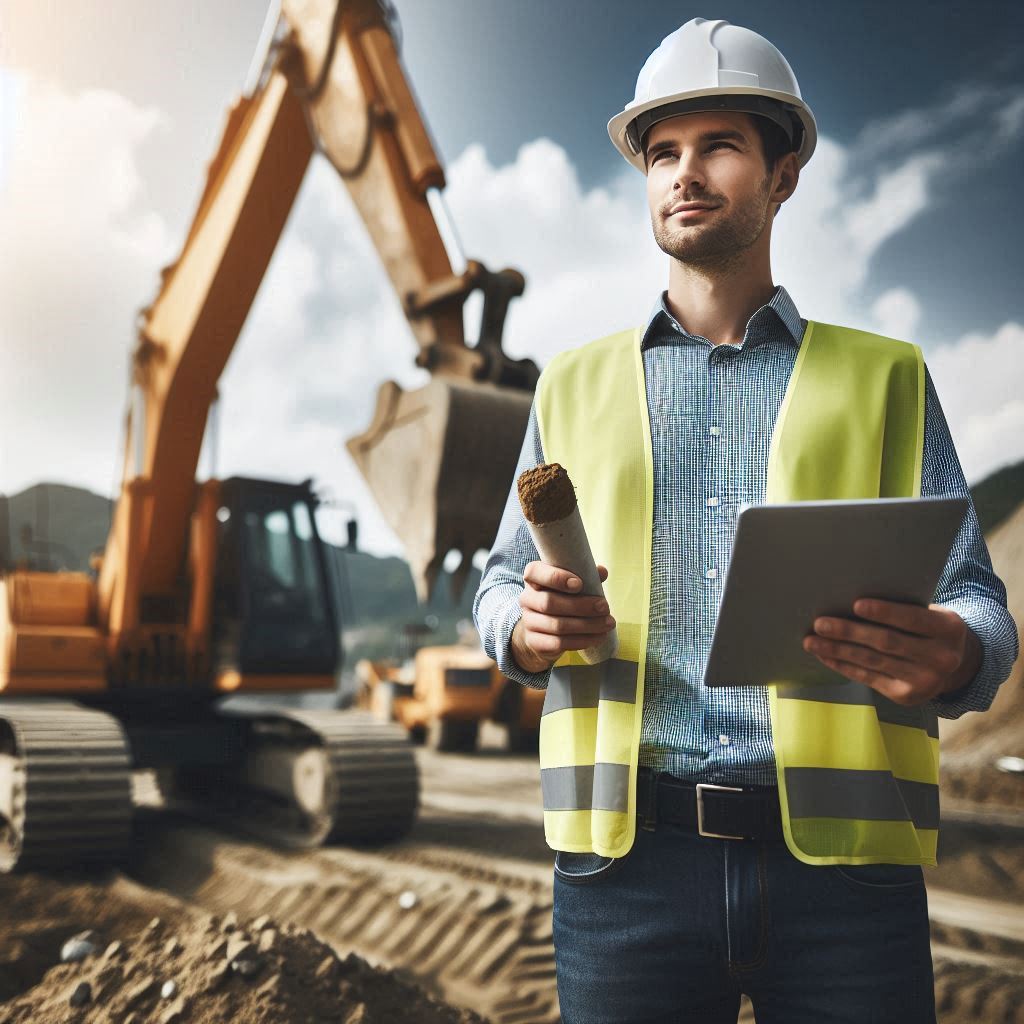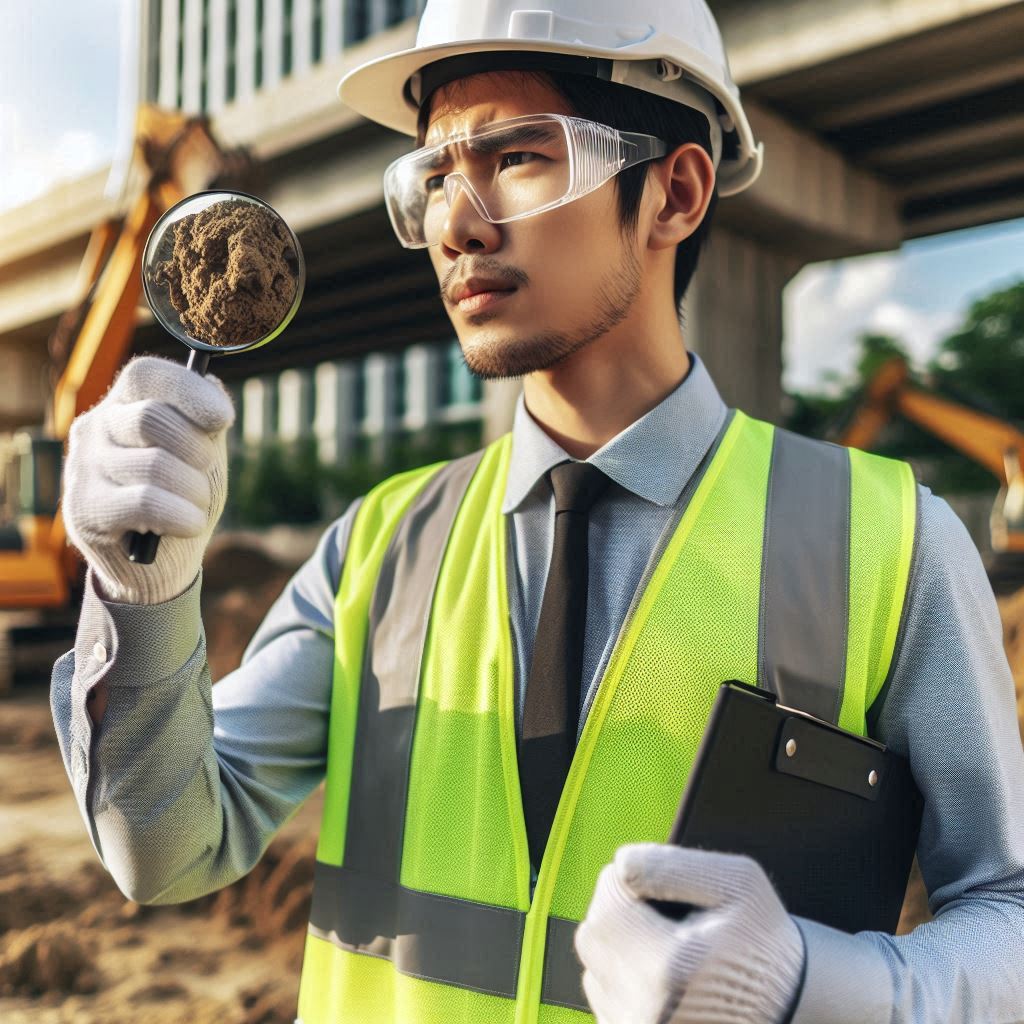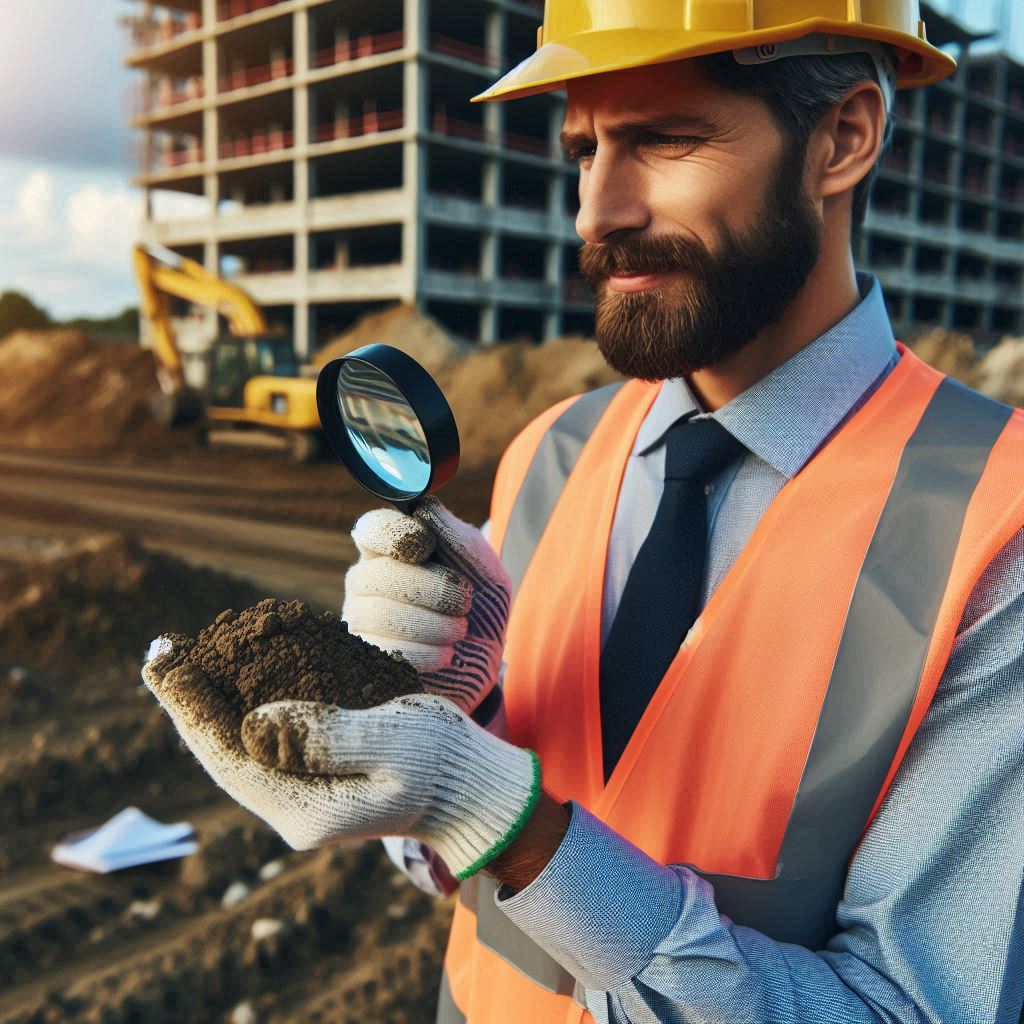Introduction
Geotechnical engineering is a crucial discipline that focuses on understanding the behavior of soil and rock.
It ensures the safety and stability of structures built on or within the ground.
This field encompasses soil mechanics, rock mechanics, and foundation engineering.
Geotechnical engineers play a key role in designing foundations, embankments, and retaining walls.
Site visits are essential in geotechnical engineering.
They provide engineers with firsthand knowledge of the ground conditions at a project site.
During a site visit, engineers assess soil and rock properties, groundwater levels, and existing structures.
This direct observation helps identify potential issues that may not be evident from desk studies alone.
Site visits allow engineers to collect soil samples and conduct field tests.
These tests offer valuable data for designing foundations and other geotechnical systems.
Accurate data collection during site visits minimizes the risk of unforeseen problems during construction.
Engineers can adjust their designs based on the actual site conditions.
Additionally, site visits help establish a clear understanding of the environmental and geological context.
They allow engineers to observe potential hazards like slope instability or soil liquefaction.
Addressing these issues early prevents costly delays and ensures project safety.
Importance of Site Visits
Ensuring Accurate Soil Samples: The Importance of Site Visits
In geotechnical engineering, site visits play a crucial role in ensuring the accuracy of soil samples.
Engineers must gather soil samples directly from the site to understand the soil’s true nature.
Relying solely on secondary data can lead to inaccuracies.
Site visits allow engineers to collect fresh samples, providing a clearer picture of soil conditions.
Proper sampling techniques during site visits ensure that samples represent the entire soil profile.
Engineers can then analyze these samples to determine their properties accurately.
This hands-on approach minimizes the risk of errors in the soil analysis process.
Identifying Potential Risks and Hazards on the Site
During site visits, engineers can identify potential risks and hazards that might not be apparent from maps or reports.
Visual inspections help uncover issues such as unstable slopes or proximity to bodies of water.
Engineers assess the potential for landslides, erosion, or flooding.
Identifying these risks early allows for proactive measures to mitigate them.
Site visits provide a chance to observe the natural environment and detect any signs of deterioration or instability.
Addressing these hazards early in the project can prevent costly problems and ensure safety.
Gathering Information for Site-Specific Design
Site visits are essential for gathering information that aids in site-specific design.
Engineers must understand the unique characteristics of each site to create effective designs.
Observations made during site visits contribute to designing foundations, retaining walls, and other structures.
Engineers collect data on soil texture, density, and moisture levels.
They also note any local geological features that might impact the design.
This information allows engineers to tailor their designs to the specific conditions of the site.
Site-specific designs are more effective and reliable than generic solutions.
Assessing soil conditions and foundation requirements
Accurate assessment of soil conditions and foundation requirements is essential for the success of any construction project.
Soil characteristics directly influence the stability and design of a foundation.
Understanding these characteristics begins with a thorough site investigation.
This involves sampling and analyzing soil to determine its composition, strength, and behavior under load.
Geotechnical engineers conduct tests such as soil borings and standard penetration tests to gather critical data.
This data reveals important aspects like soil type, moisture content, and compaction levels.
These factors determine the soil‘s load-bearing capacity and its suitability for different foundation types.
Once soil conditions are understood, engineers can design a foundation that matches the project’s requirements.
Foundations must be tailored to the soil’s load-bearing capacity to ensure stability.
For instance, in areas with loose or unstable soil, a deeper foundation or specialized techniques such as piling might be necessary to support the structure safely.
Engineers also consider potential soil issues like settlement, erosion, or shrinkage.
Addressing these concerns involves selecting appropriate foundation types and construction methods that mitigate risks.
For example, using deep foundations can prevent settlement in weak soils, while reinforcing soil with additives can improve its strength and stability.
Read: Biomedical Engineering: Regulatory Affairs
Benefits of Site Visits
Helps in Determining the Type of Foundation Needed
Site visits are crucial in determining the type of foundation required for a construction project.
By examining the soil properties directly, engineers can assess load-bearing capacities.
They can observe soil texture, moisture content, and compaction firsthand.
This hands-on evaluation helps in choosing the most appropriate foundation type.
For example, sandy soils might need deep foundations to reach stable strata, while clayey soils may require different solutions.
Engineers use site visits to avoid costly mistakes and ensure structural integrity.
Accurate foundation selection depends heavily on these initial observations.
Allows for the Evaluation of Site Access for Machinery
Site visits also facilitate the evaluation of site access for construction machinery.
Engineers assess the terrain to determine if heavy equipment can operate efficiently.
They check road conditions, entry points, and space for maneuvering.
This assessment is essential for planning the delivery and operation of machinery.
If the site has limited access, it may require modifications or special equipment.
Evaluating access during a site visit helps in preventing logistical issues and delays.
It ensures that the construction process can proceed smoothly without unexpected complications.
Enables Engineers to Identify Any Environmental Concerns
Another significant benefit of site visits is identifying potential environmental concerns.
Engineers can observe surrounding vegetation, water bodies, and wildlife habitats.
They assess how construction might impact the local ecosystem.
Identifying these concerns early helps in implementing measures to mitigate environmental damage.
Engineers can develop strategies for erosion control, waste management, and pollution reduction.
This proactive approach ensures compliance with environmental regulations and protects natural resources.
Addressing environmental issues from the start promotes sustainable construction practices.
Valuable Insights for Cost Estimation and Project Planning
Site visits provide critical insights for accurate cost estimation and project planning.
Engineers gather information on soil conditions, site access, and environmental factors.
This data helps in predicting potential challenges and associated costs.
For instance, if a site requires significant earthworks or specialized machinery, it affects the budget.
Early identification of these factors allows for better financial planning and resource allocation.
By understanding site-specific conditions, engineers can create more reliable project timelines and cost estimates.
This foresight reduces the risk of budget overruns and ensures smoother project execution.
Read: Graduate Studies in Biomedical Engineering
Common Practices during Site Visits
Conducting Field Tests to Analyze Soil Properties
Field tests are vital for understanding soil properties in geotechnical engineering.
Boreholes and sounding methods offer crucial insights into soil conditions.
By drilling boreholes, engineers can collect soil samples from various depths.
These samples reveal essential characteristics like density, moisture content, and strength.
Sounding methods, such as cone penetration tests, provide real-time data about soil resistance.
They help identify soil layers and their respective properties.
Engineers use these techniques to assess soil behavior under load and predict settlement.
Accurate soil analysis ensures safe and stable foundation design.
Utilizing Boreholes and Sounding Methods to Assess Soil Conditions
Boreholes and sounding methods play a key role in assessing soil conditions.
Engineers drill boreholes to obtain samples from subsurface layers.
They test these samples in laboratories to determine properties such as shear strength and compressibility.
Sounding methods involve inserting instruments into the ground to measure resistance.
This data helps identify soil types and their consistency.
Both techniques are essential for evaluating soil stability and bearing capacity.
By combining these methods, engineers gain a comprehensive understanding of subsurface conditions.
Mapping Out the Site to Understand Topography and Drainage Patterns
Mapping the site is crucial for understanding its topography and drainage patterns.
Topographic maps show elevation changes and landscape features.
These maps help engineers design appropriate drainage solutions and manage water flow.
Engineers analyze drainage patterns to prevent water-related issues such as erosion or flooding.
Proper site mapping allows for effective planning of foundation and structural elements.
Understanding the site’s topography ensures that construction adapts to natural landforms and minimizes environmental impact.
Collaborating with Other Professionals like Surveyors and Geologists
Collaboration with surveyors and geologists enhances the accuracy of site analysis.
Surveyors provide detailed maps and measurements of the land.
Their work supports accurate site layout and construction planning.
Geologists offer insights into soil and rock formations.
Their expertise helps in understanding the long-term stability of the site.
By working together, these professionals ensure a thorough evaluation of geotechnical conditions.
Effective collaboration leads to safer and more reliable engineering solutions.
Read: Networking Tips for Biomedical Engineers

Delve into the Subject: Challenges Faced by Industrial Engineers
Challenges Faced during Site Visit
Unforeseen Ground Conditions That Were Not Evident in the Initial Assessment
Unforeseen ground conditions often emerge during site visits, which were not evident in the initial assessment.
Soil instability, hidden voids, or unexpected rock formations can disrupt project plans.
These conditions might require immediate modifications to the engineering approach.
For instance, engineers might need to revise foundation designs or adjust excavation methods.
Identifying these issues early can save time and resources.
Promptly addressing unforeseen ground conditions helps in avoiding costly delays and ensuring the project’s success.
Limited Access to Certain Areas of the Site
Limited access to certain areas of the site presents another significant challenge.
Restrictions might arise due to physical barriers, such as structures or vegetation, or logistical constraints.
These limitations can prevent engineers from fully inspecting all areas of the site.
In such cases, engineers might need to use specialized equipment like drones or remote sensing tools to gather data.
Alternatively, they might plan additional visits or adjust their survey methods to ensure comprehensive site evaluation.
Effective planning and creative problem-solving are essential to overcoming these access challenges.
Dealing with Adverse Weather Conditions That May Impact Data Collection
Dealing with adverse weather conditions is crucial for accurate data collection.
Rain, snow, or extreme temperatures can affect soil properties and visibility, making data collection more challenging.
Engineers must adapt their techniques to account for these environmental changes.
For example, heavy rain can lead to soil saturation, altering its load-bearing capacity.
Engineers might need to reschedule site visits or employ weather-resistant tools to ensure accurate measurements.
Flexibility and preparedness are key to maintaining the reliability of the collected data despite weather-related disruptions.
Transform Your Career Today
Unlock a personalized career strategy that drives real results. Get tailored advice and a roadmap designed just for you.
Start NowEnsuring Safety Protocols Are Followed on the Site
Ensuring safety protocols are followed on the site is paramount.
Construction sites often pose significant risks, including unstable ground, hazardous materials, and heavy machinery.
Engineers must adhere to strict safety measures to protect themselves and their teams.
This includes wearing personal protective equipment, conducting regular safety briefings, and performing risk assessments.
Proper training and equipment help manage these risks effectively.
Regular safety checks and adherence to established protocols ensure a safe working environment for everyone involved.
Safety remains a top priority to prevent accidents and ensure smooth project progress.
Read: Biomedical Engineering: Impact on Public Health
Importance of Collaboration
Working closely with the client to gather project requirements
Understanding the client’s vision and needs helps tailor the site assessment and engineering solutions.
Clear communication ensures that the project aligns with the client’s expectations from the start.
Regular meetings and updates help address any emerging concerns promptly.
Consulting with other engineering disciplines for a holistic approach
enhances the accuracy of site assessments.
Collaborating with structural, environmental, and civil engineers provides a comprehensive view of the site‘s challenges.
This interdisciplinary approach ensures that all aspects of the project are considered and integrated into the final plans.
Communicating findings and recommendations effectively to all stakeholders
It is very essential.
Engineers must present data clearly and concisely to project managers, clients, and construction teams.
Effective communication helps ensure that everyone involved understands the site conditions and proposed solutions.
This transparency facilitates better decision-making and project alignment.
Incorporating feedback from site visits into the final design and construction plans
It is very crucial for project success.
Engineers should revise designs based on real-time observations and insights gained during site visits.
This iterative process helps address any issues that arise and refine the project plans accordingly.
Incorporating feedback ensures that the final design is both practical and effective
Conclusion
Site visits are crucial in geotechnical engineering.
They ensure engineers collect accurate, real-world data.
This data is essential for understanding soil conditions and assessing site stability.
Without a site visit, engineers rely on potentially outdated or incomplete information.
Site visits help identify unforeseen challenges that desk studies might miss.
Accurate data collection directly impacts project success.
It allows engineers to make informed decisions, reducing the risk of unexpected problems.
Reliable site information leads to better designs, minimizing costly changes during construction.
For projects to run smoothly, engineers must integrate site-specific data into their plans.
Engineers should prioritize site visits to enhance project outcomes.
Visiting the site ensures that all variables are considered before making design decisions.
It helps engineers address potential issues early, improving overall project efficiency.
Prioritizing site visits also boosts client satisfaction by demonstrating a thorough, proactive approach to engineering challenges.




